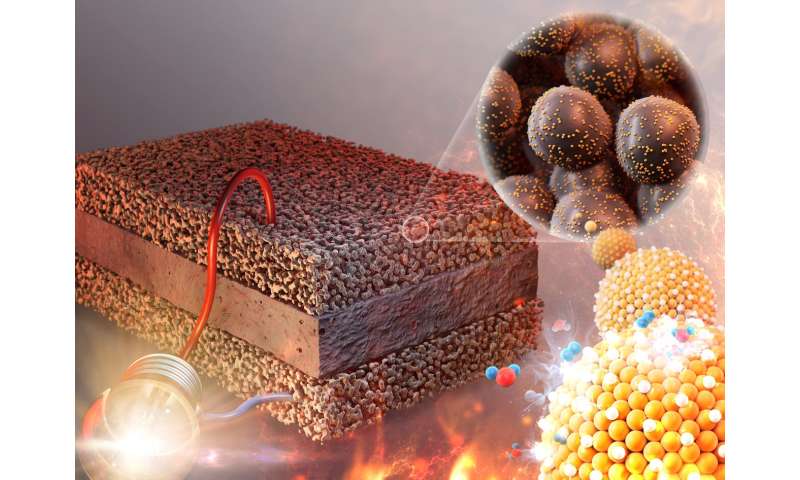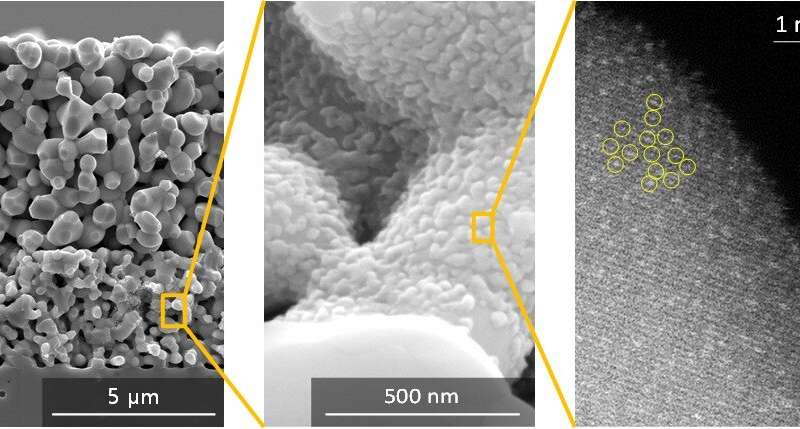
Unlike secondary batteries that need to be recharged, fuel cells are a type of eco-friendly power generation system that produce electricity directly from electrochemical reactions using hydrogen as fuel and oxygen as oxidant. There are various types of fuel cells, differing in operating temperatures and electrolyte materials. Solid oxide fuel cells (SOFCs), which use a ceramic electrolyte, are receiving increasing attention. Because they operate at high temperatures around 700 degrees Celsius, they offer the highest efficiency among fuel cell types, and can also be used to produce hydrogen by steam decomposition. For the commercialization of this technology, further improvement of cell performance is necessary, and novel high-temperature catalyst materials are highly anticipated.
Platinum (Pt)-based catalysts demonstrate excellent performance in fuel cell electrode reactions. Single-atom Pt catalysts are interesting due to their unique functionality. However, at high temperatures, the Pt atoms are not stable and easily agglomerate. Therefore, Pt single-atom catalysts have been used only in low-temperature fuel cells, like polymer-electrolyte membrane fuel cells, which are used for hydrogen electric vehicles.
A research team has now developed a catalyst that requires only a small amount of platinum for significant improvement of performance, and can operate stably at high temperatures. Dr. Kyung-Joong Yoon and Researcher Ji-Su Shin from the Center for Energy Materials Research, together with Professor Yun Jung Lee from Hanyang University have developed a single-atom Pt catalyst that can be used for SOFCs.
In their research, entire platinum atoms are evenly distributed and function individually without agglomeration, even at high temperatures. It has been experimentally shown to increase the electrode reaction rate by more than 10 times. It can also operate for more than 500 hours, even at high temperatures up to 700 degrees Celsius and improves the electric power generation and hydrogen production performance by three to four times. It is expected to accelerate the commercialization of solid oxide fuel cells (SOFCs), the next generation of eco-friendly fuel cells.

The KIST-Hanyang University research team made the single-atom catalyst by combining platinum atoms and cerium (Ce) oxide nanoparticles. Each platinum atom is individually dispersed on the surface of the cerium oxide nanoparticles, and the strong bond maintains the dispersed state of the atoms for a long duration of time, even at high temperatures, which allows all platinum atoms to be involved in the reaction. This in turn makes it possible to improve substantially the rate of the electrode reaction while minimizing the amount of platinum used.
For the fabrication, a solution containing platinum and cerium ions is injected into the electrode of the SOFC, and the catalysts are synthesized while the fuel cell is operating at a high temperature. Because the injection into the electrode can be performed easily without any special equipment, the newly developed catalyst can be readily applied to existing fuel cell fabrication processes.
Dr. Kyung-Joong Yoon from KIST said, "The catalyst developed in this study can be applied to a wide variety of solid oxide fuel cells and high-temperature electrochemical devices using an easy and simple low-cost process, so it is expected to accelerate the development of next-generation eco-friendly power generation and energy storage devices. Based on the fact that the single-atom catalyst can operate stably even at 700 degrees Celsius or higher, its application fields will be greatly expanded, including high-temperature thermochemical reactions and high-temperature electrochemical reactions."
Provided by National Research Council of Science & Technology
Citation: High-performance single-atom catalysts for high-temperature fuel cells (2020, September 25) retrieved 25 September 2020 from https://ift.tt/2S4sbPD
This document is subject to copyright. Apart from any fair dealing for the purpose of private study or research, no part may be reproduced without the written permission. The content is provided for information purposes only.
"fuel" - Google News
September 25, 2020 at 06:07PM
https://ift.tt/2S4sbPD
High-performance single-atom catalysts for high-temperature fuel cells - Phys.org
"fuel" - Google News
https://ift.tt/2WjmVcZ
Bagikan Berita Ini















0 Response to "High-performance single-atom catalysts for high-temperature fuel cells - Phys.org"
Post a Comment